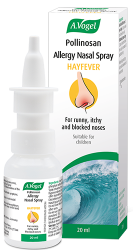An introduction to runny or blocked noses and hayfever
One of the most common symptoms of hayfever is in relation to the nose.
Some experience a runny nose and, for others they can feel completely blocked and have difficulty breathing. However, it is also common, illogical though it seems, for your nose to feel both blocked and runny.
Why does hayfever cause a runny or blocked nose?
When the body reacts to pollen, it begins to produce antibodies to fight off the potentially harmful substances. In order to do this, the chemical histamine is produced, causing inflammation and irritation in the nasal passages and airways.
The end result is swelling of the nasal passages as well as extra secretion of fluid from the tissue lining the nose and sinuses, to varying degrees. If swelling occurs in the narrow airways in your nose, you get a blocked nose. The extra secretions produced appear as mucus, giving rise to a runny nose.
You may notice that your nose continues to run after the congestion has cleared, and this is your body removing the last of the excess mucus. Unless you experience a recurring attack of hayfever, your symptoms are likely to improve after this.
Are there home remedies to help my symptoms?
A runny or blocked nose can be one of the most irritating symptoms of hayfever and perhaps as a result, several home remedies have been devised to help ease the symptom.
Breathing in moist air has often been found to relieve symptoms of a blocked or stuffy nose, as it helps to thin the mucus in your sinuses, and also soothe irritated tissue in your nose. This can be done by placing a humidifier in your room, or breathing in steam from hot water. Alternatively, a hot, steamy shower may do the trick.
Drinking plenty of fluids is important when you are feeling congested as it helps to loosen the mucus so that it can be released from your system.
Garlic has also been found to be effective in clearing a blocked nose. For the very brave it can be eaten raw, but more pleasantly can be added into cooking and meals. It can also be added into boiling water and the steam inhaled.
Of course, as your nasal problems are caused by exposure to pollen, then attempting to reduce this exposure is probably going to bring the most effective relief. When you come inside, it is important to wash your hands to avoid transferring pollen to other surfaces. However, you can also try washing your clothes and hair in an attempt to completely eradicate pollen from your home. Keeping windows and doors closed may also help in your battle against pollen.
What about herbal remedies?
If your nasal symptoms are caused by your body’s allergic response to pollen, it will be sensible to start with the root of the problem.
Alfred Vogel devised a remedy to ease hayfever symptoms by combining seven different types of tropical herbs. This formulation can be found in the licensed remedy called Pollinosan Hayfever Tablets.
You may also find that a nasal spray can help in clearing a blocked or runny nose, as it cleanses the nasal passages and also helps to protect against hayfever-inducing pollen. Pollinosan Luffa Nasal Spray is a herbal nasal spray that, unlike many chemical nasal sprays, can be used over a prolonged length of time.
Are there conventional medicines to help me?
Generally speaking, anti-histamines are the first of the conventional medicines that a hayfever sufferer will use as these reduce the chemical response in the body which aggravates the symptoms. Anti-histamines can be taken in tablet form to target all symptoms of hayfever, or in the form of a nasal spray to ease nasal congestion or runniness.
Steroid nasal sprays are also available, although they sometimes need to be taken alongside a decongestant spray to allow the medication to take full effect.









